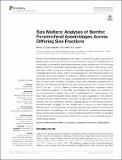Files in this item
Size matters : analyses of benthic foraminiferal assemblages across differing size fractions
Item metadata
| dc.contributor.author | Lo Giudice Cappelli, Elena | |
| dc.contributor.author | Austin, William E. N. | |
| dc.date.accessioned | 2019-12-10T12:30:18Z | |
| dc.date.available | 2019-12-10T12:30:18Z | |
| dc.date.issued | 2019-12-10 | |
| dc.identifier | 263391497 | |
| dc.identifier | f965e25b-8e2d-4192-91b4-5967567127b7 | |
| dc.identifier | 85074654161 | |
| dc.identifier | 000502970400001 | |
| dc.identifier.citation | Lo Giudice Cappelli , E & Austin , W E N 2019 , ' Size matters : analyses of benthic foraminiferal assemblages across differing size fractions ' , Frontiers in Marine Science , vol. 6 , 752 . https://doi.org/10.3389/fmars.2019.00752 | en |
| dc.identifier.issn | 2296-7745 | |
| dc.identifier.uri | https://hdl.handle.net/10023/19108 | |
| dc.description | This project was supported by the BBSRC/NERC (ref. BB/M026620/01). | en |
| dc.description.abstract | Benthic foraminiferal assemblages are the object of numerous studies spanning from (palaeo)environmental reconstructions to biomonitoring; however, the establishment of a procedure to standardize these studies remains a recent achievement. Not all studies based on benthic foraminiferal assemblages adopt the same methodology, which potentially hinders the use and comparison of samples prepared prior to the creation of a standard protocol or, indeed, without the knowledge of it. One of the main issues is to understand and possibly quantify the influence of different size fractions on foraminiferal biodiversity and richness. In this study, we analyzed benthic foraminiferal assemblages from the west coast of Shetland (Scotland), which were deliberately prepared without following the standard procedure, and were instead picked from the size fractions 63–150 μm and >150 μm. Based on assemblage composition, biodiversity indices and multivariate analyses of the data, we assessed the quality and precision of the environmental information that could be extrapolated from these samples. We found that general biodiversity trends remain the same regardless of size fraction, whereas the assemblage internal composition is significantly different between size fractions, with the small fraction retaining a greater degree of environmental sensitivity. We recommend compiling the two sample sets to produce a more holistic and detailed picture of environmental change and generate high-resolution environmental reconstructions. Nevertheless, we conclude that benthic foraminiferal assemblages picked from the large size fraction (>150 μm) still provide useful information on prevailing environmental conditions and remain useful for an overview of environmental change in these coastal settings. | |
| dc.format.extent | 8 | |
| dc.format.extent | 210587 | |
| dc.language.iso | eng | |
| dc.relation.ispartof | Frontiers in Marine Science | en |
| dc.subject | Benthic foraminifera | en |
| dc.subject | Shell size | en |
| dc.subject | Assemblages | en |
| dc.subject | Environmental reconstructions | en |
| dc.subject | Standard protocol | en |
| dc.subject | QH301 Biology | en |
| dc.subject | DAS | en |
| dc.subject.lcc | QH301 | en |
| dc.title | Size matters : analyses of benthic foraminiferal assemblages across differing size fractions | en |
| dc.type | Journal article | en |
| dc.contributor.sponsor | BBSRC | en |
| dc.contributor.institution | University of St Andrews. Coastal Resources Management Group | en |
| dc.contributor.institution | University of St Andrews. School of Geography & Sustainable Development | en |
| dc.contributor.institution | University of St Andrews. Marine Alliance for Science & Technology Scotland | en |
| dc.contributor.institution | University of St Andrews. Scottish Oceans Institute | en |
| dc.contributor.institution | University of St Andrews. St Andrews Sustainability Institute | en |
| dc.identifier.doi | 10.3389/fmars.2019.00752 | |
| dc.description.status | Peer reviewed | en |
| dc.identifier.grantnumber | BB/M026620/1 | en |
This item appears in the following Collection(s)
Items in the St Andrews Research Repository are protected by copyright, with all rights reserved, unless otherwise indicated.

